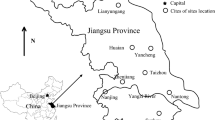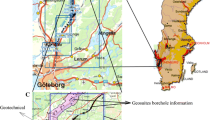Abstract
The East Port Said region, one of the most vibrant areas in the East Nile Delta, is a strategic economic zone that is receiving growing local and global investments. The near surface formations, however, typically comprise very soft clays deposited during the Holocene epoch. Collecting undisturbed samples and conducting laboratory evaluation of these sensitive soils could be cumbersome, inaccurate, and uneconomical. Therefore, the use of in-situ cone penetration test (CPT) provides a viable and convenient characterization alternative. This study attempts to establish site-specific correlations between the measurements of the static CPT and shear wave velocities (Vs) furnished by seismic piezocone soundings. The mathematical regressions were developed utilizing a number of measurements and factors, namely, tip resistance, sleeve friction, effective stress, depth, voids ratio, and soil behavior type index. The proposed correlations demonstrate different levels of predictability, with a few warranting confidence in employing static CPT for estimation of Vs profile in this region. Two correlations, one utilizing void ratio and tip resistance and the other employing sleeve friction solely, have shown to provide the most reliable Vs predictions for the soft clay in the East Nile Delta.







Similar content being viewed by others
References
Abdallah G (2006) Management of groundwater aquifers along the Mediterranean Sea in Sinai Peninsula. In: The 2nd international conference on water resources and arid environment
Ahmad I, Waseem M, Abbas M, Ayub U (2015) Evaluation of shear wave velocity correlations and development of new correlation using cross-hole data. Int J Georesour Environ-IJGE 1(1):1
Ahmed SM (2017) Correlating the shear wave velocity with the cone penetration test. In: Conference: 2nd international conference on geotechnical research and engineering (ICGRE’17), Barcelona, Spain
Andrus RD, Mohanan NP, Piratheepan P, Ellis BS, Holzer TL (2007) Predicting shear-wave velocity from cone penetration resistance. In: Proceedings of the 4th international conference on earthquake geotechnical engineering, Thessaloniki, Greece, vol 2528
Bouckovalas G, Kalteziotis N, Sabatakakis N, Zervogiannis H (1989) Shear wave velocity in a very soft clay-measurements and correlations. In: Proceedings of the 12th international conference soil mechanics foundation engineering (ICSMFE), Rio de Janeiro, Brazil, pp 191–194
Cai G, Puppalab AJ, Liau S (2014) Characterization on the correlation between shear wave velocity and piezocone tip resistance of Jiangsu clays. Eng Geol 171:96–103
Hamed OM, Mansour M, Abdel-Rahman AH, El-Nahhas FM (2017) Geotechnical characterization of Port-Said clay. In: 19th international conference on soil mechanics and geotechnical engineering, Seoul, South Korea, Geotechnical and Geological Characteristics of Local Deposits and Formations, September 2017, pp 2991–2994
Hegazy YA, Mayne PW (1995) Statistical correlations between Vs and CPT data for different soil types. In: Proceedings, symposium on cone penetration test (CPT’s95). Swedish Geotechnical Society, vol 2, pp 173–178
Hegazy YA, Mayne PW (2006) A global statistical correlation between shear wave velocity and cone penetration data. In: Site and geomaterial characterization. Geotechnical Special Publication, pp 243–248. https://doi.org/10.1061/40861(193)31
Iyisan R (1996) Correlations between shear wave velocity and in-situ penetration test results. Tech J Chamber Civil Eng Turkey 7:1187–1199 (in Turkish)
Long M, Donohue S (2010) Characterization of Norwegian marine clays with combined shear wave velocity and piezocone cone penetration test (CPTU) data. Can Geotech J 47(7):709–718
Madiai C, Simoni G (2004) Shear wave velocity-penetration resistance correlation for Holocene and Pleistocene soils of an area in central Italy. In: Geotechnical and geophysical site characterization. Proceedings of the 2nd international conference on site characterization, Porto
Mansour MF (2018) Constitutive behavior of Port-Said Clay under seismic and small strain static conditions. Ain Shams Eng J 9(4):2983–2991
Mayne PW (2006) In-situ test calibrations for evaluating soil parameters. In: Characterisation and engineering properties of natural soils. Proceedings of the 2nd international workshop on characterisation and engineering properties of natural soils. Taylor & Francis, pp 1601–1652
Mayne PW, Rix GJ (1995) Correlations between shear wave velocity and cone tip resistance in natural clays. Soils Found 35(2):107–110
Piratheepan P (2002) Estimating shear-wave velocity from SPT and CPT data. M.S. Thesis, Clemson University
Robertson PK (2009) Interpretation of cone penetration tests—a unified approach. Can Geotech J 46(11):1337–1355
Robertson PK, Cabal KL (2015) Guide to cone penetration testing for geotechnical engineering, 6th edn. Gregg Drilling and Testing, Inc
Robertson PK, Woeller DJ, Finn WDL (1992) Seismic cone penetration test for evaluating liquefaction potential under cyclic loading. Can Geotech J 29(4):686–695
Shahri AA, Naderi S (2016) Modified correlations to predict the shear wave velocity using piezocone penetration test data and geotechnical parameters: a case study in the southwest of Sweden. Innov Infrastruct Solut 1(1):13
Tün M (2003) Investigation of the characteristics of Eskişehir soils due to shear wave velocity and determination of their fundamental vibration periods (Doctoral dissertation, Dissertation, Department of Physics, Anadolu University Institute of Science and Technology, Turkey (in Turkish)
Wair BR, DeJong JT, Shantz T (2012) Guidelines for estimation of shear wave velocity profiles. Pacific Earthquake Engineering Research Center
Author information
Authors and Affiliations
Corresponding author
Additional information
Publisher's Note
Springer Nature remains neutral with regard to jurisdictional claims in published maps and institutional affiliations.
Rights and permissions
About this article
Cite this article
Fayed, A.L., Mousa, A.A. Shear Wave Velocity in the East Nile Delta Clay: Correlations with Static CPT Measurements. Geotech Geol Eng 38, 2303–2315 (2020). https://doi.org/10.1007/s10706-019-01089-4
Received:
Accepted:
Published:
Issue Date:
DOI: https://doi.org/10.1007/s10706-019-01089-4




